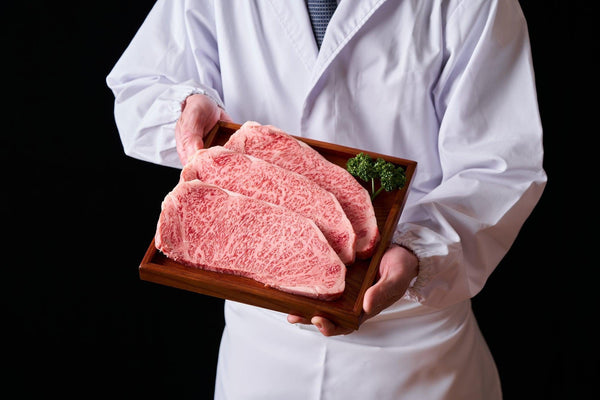
Jump to:
Although the term “Wagyu” is now commonly used in English-speaking countries, it literally just means ‘Japanese cow’. Whereas tales of beer-stupefied cows wandering happily around the fields of western Japan before retiring to their barns for a full shiatsu massage are almost certainly overblown, it is clear that a certain mystique has developed around the careful way Wagyu cattle are raised and the quality of the meat produced.
There are perhaps geographical factors behind Japan’s emphasis on producing expensive high-quality meat. Japan being largely comprised of rocks, rice fields, and cities does not have endless grasslands for cattle to roam like the United States, and so there is no way for Japan to compete in terms of low-cost, mass-produced beef. Instead, Japan concentrated on providing beef as a luxury good.
In this blog post, we will look at the history of Wagyu production in Japan, how the cattle is raised, and what makes Wagyu special, as well as how it is graded. We shall also look at different versions of Wagyu around the world, the most advisable way to cook it, and the best food and drink with which to enjoy Wagyu.
History Of Wagyu In Japan

According to an article in the Asian-Australasian Journal of Animal Sciences (“The Japanese Wagyu beef industry: current situation and future prospects – A review”), the term Wagyu refers to four Japanese breeds (Black, Brown, Shorthorn, and Polled). However, the majority of Wagyu produced today is from Japanese black cattle, which are genetically predisposed to produce carcass lipids containing higher concentrations of monounsaturated fatty acids than other breeds.
Although there is some evidence that the first cows came to Japan from China around 200AD, as a result of its Buddhist roots, meat was not commonly eaten in Japan until the Meiji Restoration when the emperor broke the taboo by eating meat in public in 1872. For the 2,000 years up to that point, cows had been used primarily as labor animals. In the next 50 years, Japanese farmers introduced large amounts of cattle and these foreign breeds were mixed with local cattle to create the different strains currently referred to as Wagyu today.
How Are Wagyu Raised?

A common misperception about Wagyu, particularly prevalent in Western media, is that the cows are raised like foie gras; that is to say, they are deliberately fattened in a restricted environment to produce the heavily marbled meat. In fact, the opposite approach is taken. Stress produces a hormone called cortisol that degrades meat quality, so the aim is to keep the cows in a stress-free environment from birth until slaughter.
Wagyu cows are raised by specialty breeders in farms (where they are even given jackets in the winter to keep them warm) until they are between seven and ten months old, at which point they are auctioned off to a feeding farm along with a certificate that certifies their bloodline. They are then allowed to roam and graze in a stress-free environment and fed a strict diet of hay, grain, and wheat to allow them to gain weight slowly (approximately 2.5 pounds (just over 1 kg) per day) over the course of two or three years until they reach around 1,500 pounds or 680 kg. Wagyu farmers never speed up this process with growth-promoting hormones or steroids, which would detract from the quality of the meat.
What Makes Wagyu Special?

What sets Wagyu apart from other types of beef is its exquisite marbling, that is the way that the fat is evenly distributed throughout the meat in clear white lines, known as “霜降り”(shimo-furi). The reason for this marbling is largely based on genetics and how they are bred to have a large quantity of IMF (intra-muscular fat). It is this that gives Wagyu its trademark “melt-in-the-mouth” quality.
In addition to genetics, the high fat content of Wagyu is the result of its diet, which, as previously discussed is a combination of hay, grain, and wheat, and this allows them to gain more fat than they would on a purely grass-fed diet.
Grades of Wagyu

You may be aware that different ranks are given to different types of beef in Japan. The grades consist of a letter (A to C) and a number (1 to 5). These are determined by the Japan Meat Grading Agency based on the beef carcass transaction standards approved by the Ministry of Agriculture, Forestry, and Fisheries.
One might naturally think that A5 is guaranteed to be the tastiest meat, but, in actual fact, this rank does not evaluate taste. The letter denotes “yield grade," which is a rank that assesses "how much beef product can be obtained from the cattle, while the number is a summary of four factors, including its color, the tightness and texture of the beef, the color and quality of the fat, and the total amount of fat in the beef.
Although the taste of the beef is not directly assessed, it is a fairly safe bet that the higher-ranked types of beef (particularly in terms of number) will be of superior quality and taste.
Different Types Of Wagyu

It is said that sports superstar Kobe Bryant was so named after his father enjoyed a particularly scrumptious cut of meat during a visit to Japan, and for many people to this day, Wagyu equals Kobe beef. Of course, its popularity is not without reason. It has a delicate sweetness, a fine, smooth lingering taste, and a distinctive aroma. But Kobe beef is certainly not the only show in town and there are a host of other types of Wagyu that we would recommend trying.
Matsuzaka beef, hailing from Mie Prefecture, contains a high percentage of unsaturated fatty acids giving it a true “melt in the mouth” quality. This beef has a mellow taste and a sweet, elegant aroma.
Characteristics of Yonezawa beef, from Yamagata Prefecture, include its moist texture, the tender juiciness of the meat, and its mild flavor.
Oumi beef, from Shiga Prefecture, is tender with fine marbling. The fat has a distinctive sheen and a unique consistency. It is also characterized by the fact that it does not tend to lose moisture during transportation.
Different Versions Of Wagyu Around The World
With the huge popularity of Wagyu in Japan, other countries have been keen to get on the act and gain a foothold in the luxury beef market. We will take a brief look at American Wagyu and Australian Wagyu below.
American Wagyu

The phenomenon of American Wagyu can be traced back to 1976 when four Wagyu bulls were brought to the United States from Japan. The American Wagyu Association currently estimates that they are around 30,000 Wagyu-influenced cattle being raised in the United States, with less than 5,000 being full-blood (both parents 100% genetically traceable to original Wagyu cattle). Whereas in Japan, only full-blood cattle qualify as Wagyu, in the United States, it is sufficient for the cows to hold a 50% genetic link to be given the name Wagyu, with the majority of cows being crossbred with black Angus cattle.
Australian Wagyu

Australia is another key player in the global Wagyu market. Although Australia received Wagyu genetics in the form of frozen semen and embryos in 1991, the first live full-blood cattle did not arrive from Japan until 1997. Like American Wagyu, Australian Wagyu can qualify as Wagyu if it has a 50% genetic link to original Wagyu cattle, and it is estimated that only 5% of Australian Wagyu is from full-blood Wagyu.
How To Cook A Good Wagyu Steak

So once you have decided to blow your monthly food budget on a single Wagyu steak, the last thing you want to do is ruin it during the cooking process. This section aims to help you avoid this disastrous scenario by providing the following steps below to help you get the most from your Wagyu steak experience.
- First, salt the steak well on both sides. This is done to draw out the fat and juices of the steak and create a delicious and flavorful crust on the outside of the steak.
- After completing step (1), leave the steak at room temperature for approximately 30 minutes. This ensures that the whole steak is at the same temperature when you start cooking it.
- Heat a cast iron pan at medium heat until the pan is hot.
- To prevent the steak from sticking, use the fat of the steak itself, which you can do by rubbing the fat cap of the steak in the heated pan.
- Cook the steak on one side for approximately 90 seconds. Then flip and cook until the internal temperature of the steak reaches about 135°F (58℃) for the case of medium-rare.
- Allow it to rest for 5 minutes, then thinly slice, and serve.
Other Ways to Enjoy Wagyu
Although Wagyu is most famously eaten as a steak, there are certainly other ways to enjoy it. Using Wagyu as the beef in this sukiyaki recipe promises to make it even more tasty. We would also recommend using it in Japanese BBQ or yakiniku (click here for everything you will need when making this).
Is Wagyu Healthy?
Due to the high-fat content of Wagyu, it may be tempted to consider it a less healthy type of beef. However, it is important to consider the type of fat it contains. Wagyu contains large amounts of mono-unsaturated fats, as well as omega 3 and omega-6 essential fatty acids, and is lower in cholesterol.
There is evidence that mono-unsaturated fats (MUFA) can not only be used as energy to support cell growth, but also lower cholesterol, prevent cardiovascular disease, and perhaps most surprisingly, even contribute to weight loss.
Food And Drink To Accompany Your Wagyu

Wagyu in Japan is commonly eaten with common with foods such as grilled vegetables, rice, and pickles, and various sauces such as horseradish, wasabi, ponzu sauce, steak sauce, and shoyu (Japanese soy sauce).
In terms of drinks, wagyu pairs very well with full-bodied red wines, such as Cabernet Sauvignon, as well as medium-bodied reds like Shiraz.
Although it has traditionally been thought difficult to match Nihonshu with Wagyu, there have been several initiatives recently that aim to change this way of thinking. Innovative sake company Nihonshu Oendan has partnered with Wagyu specialty restaurant Yakiniku Yazawa to create tasting sets combining the two.
Is Wagyu Really Worth The Hype?

It is a fact that Wagyu is not to everyone’s taste. Many people complain that it is far too fatty to be enjoyed as steak. Given that Wagyu typically costs at least three times more than similar non-Wagyu cuts of meat in Japan, it is worth asking the question of whether it is really worth the hype.
The charge labeled at Wagyu as being too fatty is usually made by people used to eating large portions of steak. It is common to eat a pound (450 g) of leaner American steak, and if you tried to eat that much Wagyu, in addition to the pain in your wallet, the fat would be very overpowering.
Wagyu should be enjoyed as a luxury meat in small quantities and on special occasions. Think of it in the same way as foie gras. Although very tasty, you wouldn’t want a lot of it. Eaten like this, many would agree that its soft, buttery taste makes it the tastiest beef available.
Do you love Wagyu or think it over-hyped? Let us know in the comments.


0 comments